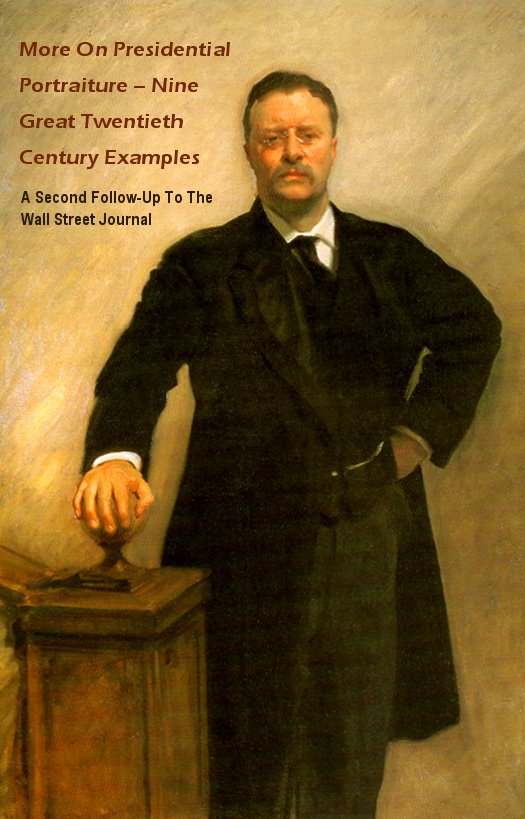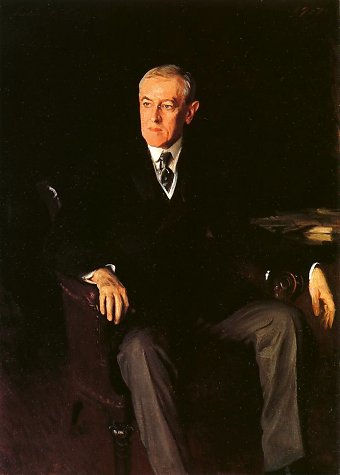 |
| |
Theodore Roosevelt, 1903
John Singer Sargent.
Oil on canvas, 58 x 40 inches.
The White House, Washington, D.C. |
 he
author and art historian Catesby Leigh, writing
recently in the Wall Street Journal (December
18, 2007: "Why Presidential Portraiture
Lost Its Stature") presented a two-pronged
critique of contemporary Presi-dential portraiture,
claiming that "the once-august genre of
presidential portraiture has lost its shine."
Leigh's two-fold thesis was: first: early examples,
such as Gilbert Stuart's George Washington (The
famous Lansdowne version) were based on poses
from classical sculpture and included elements
of power and grandeur, such as columns, velvet
drapes, swords and even Roman fasces, (thus
imparting the power of the office). Why, the
1982 White House portrait of Gerald R. Ford
(by artist Everett Raymond Kinstler) shows merely
a man in a three-piece suit! It could be "a
bank president or Major League Baseball commissioner"
complains Leigh. Secondly, contemporary Presidential
portraits, including Kinstler's Ford, Greta
Kempton's Truman (1947), Norman Rockwell's Nixon
(1968) and Nelson Shanks' Clinton (2005), look,
cries author Leigh, like "touched-up photographs."
"The poetry is just about gone," opines
Leigh. Well, let's have a look. he
author and art historian Catesby Leigh, writing
recently in the Wall Street Journal (December
18, 2007: "Why Presidential Portraiture
Lost Its Stature") presented a two-pronged
critique of contemporary Presi-dential portraiture,
claiming that "the once-august genre of
presidential portraiture has lost its shine."
Leigh's two-fold thesis was: first: early examples,
such as Gilbert Stuart's George Washington (The
famous Lansdowne version) were based on poses
from classical sculpture and included elements
of power and grandeur, such as columns, velvet
drapes, swords and even Roman fasces, (thus
imparting the power of the office). Why, the
1982 White House portrait of Gerald R. Ford
(by artist Everett Raymond Kinstler) shows merely
a man in a three-piece suit! It could be "a
bank president or Major League Baseball commissioner"
complains Leigh. Secondly, contemporary Presidential
portraits, including Kinstler's Ford, Greta
Kempton's Truman (1947), Norman Rockwell's Nixon
(1968) and Nelson Shanks' Clinton (2005), look,
cries author Leigh, like "touched-up photographs."
"The poetry is just about gone," opines
Leigh. Well, let's have a look.
 |
Woodrow Wilson, 1917
John Singer Sargent.
Oil on canvas, 60 x 43 inches.
The White House,
Washington, D.C.
|
Leigh correctly senses
a turning point in the work of the
great John Singer Sargent (1856-1925),
who went twice to the White House:
in 1903, to paint Theodore Roosevelt,
and again in 1917 to record Woodrow
Wilson. Both paintings are notable
in the White House collection in that
both are totally devoid of any background
elements. In the Roosevelt (shown
at the beginning of this article),
we have the newell post of the Grand
Staircase, to allow the President
to place his right hand there in a
commanding gesture. In the Wilson,
only the merest suggestion of the
presidential desk emerges from an
impenetrable dark background. Both
paintings otherwise eschew the "trappings
of office" and concentrate on
the personality, character, and appearance
of the man temporarily occupying the
most powerful office on earth.
|
|
|